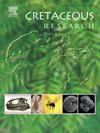Side by side with titans: A new rebbachisaurid dinosaur from the Huincul Formation (upper Cenomanian) of Patagonia, Argentina
IF 1.7
3区 地球科学
Q1 GEOLOGY
引用次数: 0
Abstract
Rebbachisaurids are medium to large-sized, non-selective and ground-level browser diplodocoid sauropods, and they are characterised by highly specialised skulls, widely pneumatized axial elements and gracile appendicular skeletons. Known from the Early Cretaceous to the early Late Cretaceous, the rebbachisaurid fossil record is particularly diversified in Gondwana, with several specimens found in North Africa and South America. Notably, Patagonia has yielded over more than half of all known Rebbachisauridae, including the most basal forms and the youngest rebbachisaurid remains to date. Herein, we describe a new species of Rebbachisauridae from the Huincul Formation (upper Cenomanian) of the Neuquén Basin (Patagonia, Argentina): Astigmasaura genuflexa gen. et sp. nov. New laboratory work provided the complete osteology of the specimen MAU-Pv-EO-629, complementing the previously published hind limb anatomy. Thus, the type material of Astigmasaura comprises the posterior portion of an articulated, postcranial skeleton of a single, morphologically adult individual. Astigmasaura shares different conditions with other Rebbachisauridae, including anterior caudal vertebrae with tall neural spines and tetraradiate neural laminae, asymmetric middle haemal arches, mediolaterally compressed proximal tibiae, and femur with medially inclined distal condyles. Furthermore, Astigmasaura shows a unique combination of diagnostic features that distinguish it from all other sauropods. This new record not only provides new morphological information about the caudal and pelvic girdle anatomy of Rebbachisauridae, which is poorly known to date, and suggests a greater taxonomic diversification within the family during the last stages of its evolutionary history than known before.
与泰坦并排:阿根廷巴塔哥尼亚Huincul组(上塞诺曼尼亚)发现的一种新的雷巴奇龙
Rebbachisaurids是中型到大型,非选择性和地面浏览梁龙科蜥脚类动物,它们的特点是高度特化的头骨,广泛气动的轴向元素和纤细的附肢骨骼。从早白垩纪到晚白垩纪早期,rebbachisaurd的化石记录在冈瓦纳特别多样化,在北非和南美洲发现了几个标本。值得注意的是,巴塔哥尼亚出土了超过一半的已知Rebbachisauridae,包括最基本的形式和迄今为止最年轻的Rebbachisauridae。在此,我们描述了一种来自neuqu 盆地(巴塔哥尼亚,阿根廷)Huincul组(上Cenomanian)的Rebbachisauridae新种:Astigmasaura genuflexa gen. et sp. 11 .新的实验室工作提供了标本MAU-Pv-EO-629的完整骨学,补充了先前发表的后肢解剖。因此,尾柱头的类型材料包括一个单一的、形态上的成年个体的关节、颅后骨骼的后部。尾前椎骨神经棘高,神经板四散,中间血弓不对称,胫骨近端内侧受压,股骨远端髁内侧倾斜。此外,Astigmasaura表现出独特的诊断特征组合,使其区别于所有其他蜥脚类动物。这一新记录不仅提供了迄今所知甚少的Rebbachisauridae科尾部和骨盆带解剖结构的新形态学信息,而且表明该科在其进化史的最后阶段具有比以前已知的更大的分类多样化。
本文章由计算机程序翻译,如有差异,请以英文原文为准。
求助全文
约1分钟内获得全文
求助全文
来源期刊

Cretaceous Research
地学-地质学
CiteScore
4.10
自引率
19.00%
发文量
235
审稿时长
12 weeks
期刊介绍:
Cretaceous Research provides a forum for the rapid publication of research on all aspects of the Cretaceous Period, including its boundaries with the Jurassic and Palaeogene. Authoritative papers reporting detailed investigations of Cretaceous stratigraphy and palaeontology, studies of regional geology, and reviews of recently published books are complemented by short communications of significant new findings.
Papers submitted to Cretaceous Research should place the research in a broad context, with emphasis placed towards our better understanding of the Cretaceous, that are therefore of interest to the diverse, international readership of the journal. Full length papers that focus solely on a local theme or area will not be accepted for publication; authors of short communications are encouraged to discuss how their findings are of relevance to the Cretaceous on a broad scale.
Research Areas include:
• Regional geology
• Stratigraphy and palaeontology
• Palaeobiology
• Palaeobiogeography
• Palaeoceanography
• Palaeoclimatology
• Evolutionary Palaeoecology
• Geochronology
• Global events.
 求助内容:
求助内容: 应助结果提醒方式:
应助结果提醒方式:


